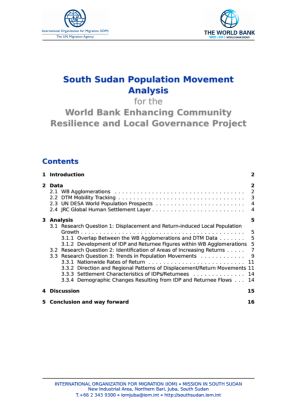-
Countries
-
Data and Analysis
-
Special Focus
-
Crisis Responses
South Sudan — Population Movement Analysis for the World Bank ECRLG Project (December 2019)

Contact
DTM South Sudan, SouthSudanDTM@iom.int
Language
English
Location
South Sudan
Period Covered
Jun 01 2019
Jun 30 2019
Activity
- Mobility Tracking
- Baseline Assessment
The Government of South Sudan requested World Bank support for a project that improves local services, strengthens local governance, and increases social cohesion. Accordingly, the World Bank (WB) created the “Enhancing Community Resilience and Local Governance” project which will focus on addressing basic service delivery needs on the ground, particularly in areas where the displaced have returned. The World Bank approached IOM South Sudan to perform tailored research and analysis that will assist the World Bank task team, host country clients, and implementation partners as they design and prepare the new operation. The research requested includes population movement analysis, which – building on IOM South Sudan’s Displacement Tracking Matrix (DTM) data as well as existing secondary data – addresses the following research questions:
(1) The World Bank has identified 34 agglomerations as large and most rapidly growing population centers in the South Sudan. Using DTM data, the analysis requested shall determine the degree of overlap between these agglomerations and DTM data with regard to the concentration of returnees in the country. It shall thereby assess the extent to which population growth in these areas is attributable to return movements of refugees and IDPs.
(2) The analysis requested shall identify other agglomerations (whether rural or urban) additional to the 34 identified by the World Bank, which show rapid population growth due the inflow of returnees, using DTM and other available data.
(3) The analysis requested shall provide overall trends in population movement over the last 44 months, including: nationwide rates of return; direction and regional patterns of returns; predominant ethnic composition of population flows; demographic changes in key areas of returnee concentrations resulting from these flows; settlement patterns of returning refugees and IDPs.
